广州小学英语时间介词和方位介词
广州小学英语时间介词和方位介词
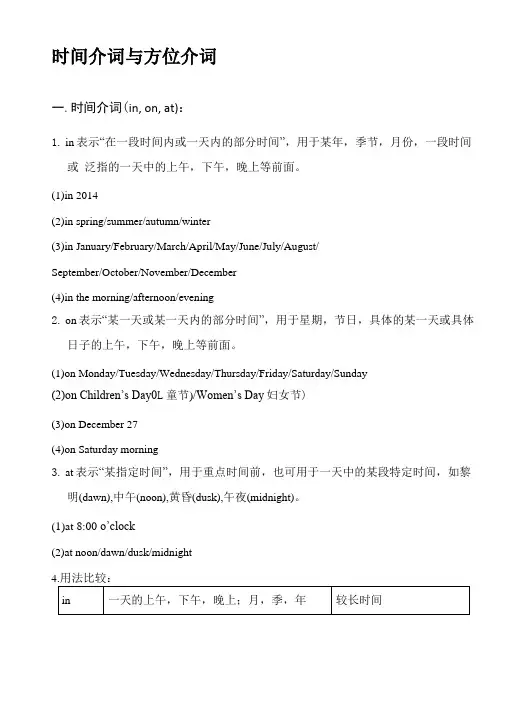
时间介词与方位介词一.时间介词(in, on, at):1.in表示“在一段时间内或一天内的部分时间”,用于某年,季节,月份,一段时间或泛指的一天中的上午,下午,晚上等前面。
(1)in 2014(2)in spring/summer/autumn/winter(3)in January/February/March/April/May/June/July/August/September/October/November/December(4)in the morning/afternoon/evening2.on表示“某一天或某一天内的部分时间”,用于星期,节日,具体的某一天或具体日子的上午,下午,晚上等前面。
(1)on Monday/Tuesday/Wednesday/Thursday/Friday/Saturday/Sunday(2)on Children’s Day0L童节)/Women’s Day妇女节)(3)on December 27(4)on Saturday morning3.at表示“某指定时间”,用于重点时间前,也可用于一天中的某段特定时间,如黎明(dawn),中午(noon),黄昏(dusk),午夜(midnight)。
(1)at 8:00 o’clock(2)at noon/dawn/dusk/midnight二地点介词(in,at,on):at (1)表示在小地方(〈城镇);(2)表示“在……附近,旁边”例:at school, at the door如:I saw Jiamin at the swimming pool.See you at the party.in⑴表示在大地方(>城镇);(2)表示“在…范围之内”。
例:in china, in the school yard如:He lives in Paris with his wife.on (1)表示在物体表面;(2)表示在某个方向例:on the table在桌子上on the left/right在左边/右边三.方位介词:1.含义:用来表示人或物的位置的词语。
小学英语介词at、in、on
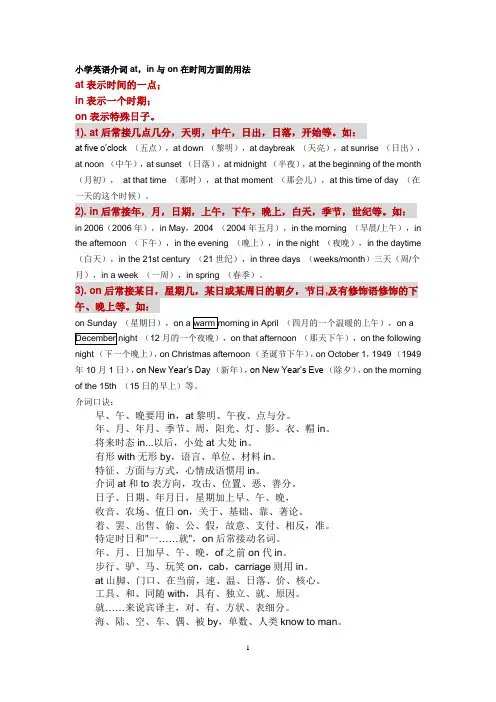
早、午、晚要用in,at黎明、午夜、点与分。
年、月、年月、季节、周,阳光、灯、影、衣、帽in。
将来时态in...以后,小处at大处in。
有形with无形by,语言、单位、材料in。
特征、方面与方式,心情成语惯用in。
介词at和to表方向,攻击、位置、恶、善分。
日子、日期、年月日,星期加上早、午、晚,收音、农场、值日on,关于、基础、靠、著论。
着、罢、出售、偷、公、假,故意、支付、相反,准。
特定时日和"一……就",on后常接动名词。
年、月、日加早、午、晚,of之前on代in。
步行、驴、马、玩笑on,cab,carriage则用in。
at山脚、门口、在当前,速、温、日落、价、核心。
工具、和、同随with,具有、独立、就、原因。
就……来说宾译主,对、有、方状、表细分。
海、陆、空、车、偶、被by,单数、人类know to man。
this、that、tomorrow,yesterday,next、last、one。
接年、月、季、星期、周,介词省略已习惯。
over、under正上下,above、below则不然,若与数量词连用,混合使用亦无关。
'beyond超出、无、不能,against靠着,对与反。
besides,except分内外,among之内along沿。
同类比较except,加for异类记心间。
原状because of,、owing to、due to表语形容词under后接修、建中,of、from物、化分。
before、after表一点, ago、later表一段。
before能接完成时,ago过去极有限。
since以来during间,since时态多变换。
与之相比beside,除了last but one。
复不定for、找、价、原,对、给、段、去、为、作、赞。
快到、对、向towards,工、学、军、城、北、上、南。
but for否定用虚拟,复合介词待后言。
ing型由于鉴,除了除外与包合。
广州版小学英语知识点总结
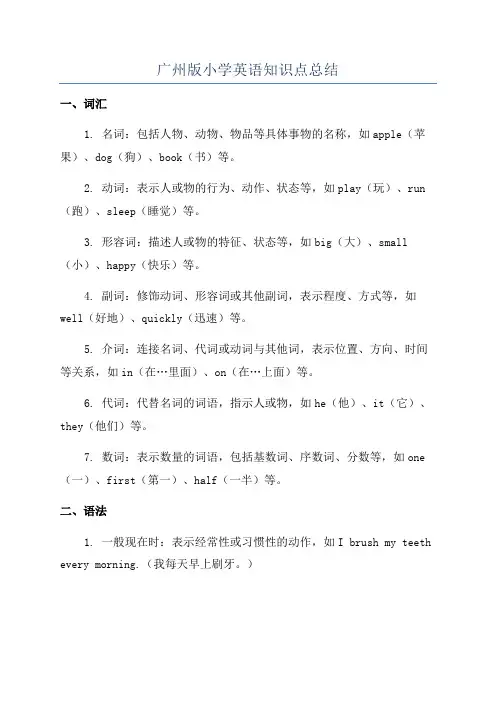
广州版小学英语知识点总结一、词汇1. 名词:包括人物、动物、物品等具体事物的名称,如apple(苹果)、dog(狗)、book(书)等。
2. 动词:表示人或物的行为、动作、状态等,如play(玩)、run (跑)、sleep(睡觉)等。
3. 形容词:描述人或物的特征、状态等,如big(大)、small (小)、happy(快乐)等。
4. 副词:修饰动词、形容词或其他副词,表示程度、方式等,如well(好地)、quickly(迅速)等。
5. 介词:连接名词、代词或动词与其他词,表示位置、方向、时间等关系,如in(在…里面)、on(在…上面)等。
6. 代词:代替名词的词语,指示人或物,如he(他)、it(它)、they(他们)等。
7. 数词:表示数量的词语,包括基数词、序数词、分数等,如one (一)、first(第一)、half(一半)等。
二、语法1. 一般现在时:表示经常性或习惯性的动作,如I brush my teeth every morning.(我每天早上刷牙。
)2. 疑问句和否定句:在句子中加入疑问词或助动词构成疑问句,如Does she have a pet?(她有宠物吗?)为动词加not构成否定句,如I do not like vegetables.(我不喜欢蔬菜。
)3. 一般过去时:表示过去发生的动作或存在的状态,如He played football yesterday.(他昨天踢足球。
)4. 有...的人或物:用“have/has”表达人或物具有其中一种特征或拥有其中一种东西,如I have a cat.(我有一只猫。
)5. 情态动词can:表示能力、许可或可能性,如He can swim.(他会游泳。
)6. 以...做为:用介词“as”表示对象具有其中一种特征或扮演其中一种角色,如He works as a doctor.(他以医生为职业。
)7. 形容词的比较级和最高级:用于比较两个或多个事物的大小、高低等,如She is taller than me.(她比我高。
小学英语表示时间、地点和位置的常用介词总结
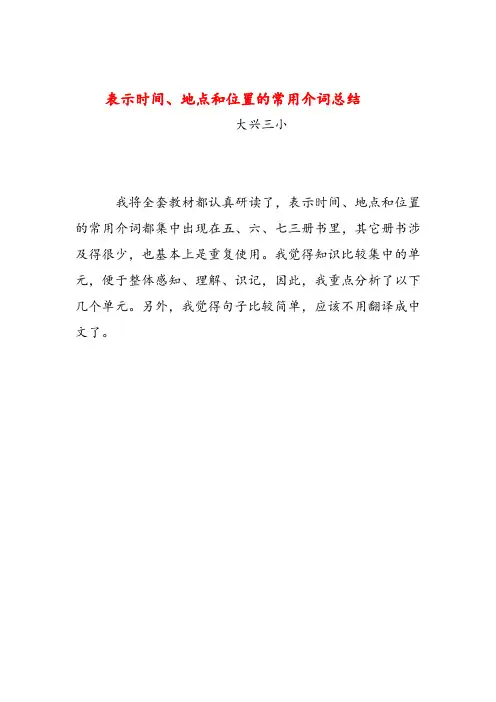
表示时间、地点和位置的常用介词总结大兴三小我将全套教材都认真研读了,表示时间、地点和位置的常用介词都集中出现在五、六、七三册书里,其它册书涉及得很少,也基本上是重复使用。
我觉得知识比较集中的单元,便于整体感知、理解、识记,因此,我重点分析了以下几个单元。
另外,我觉得句子比较简单,应该不用翻译成中文了。
地点和位置常用介词北师大版第五册单元名称: Unit 4 Where is it?页码:P34The bird is on the rock.The snake is under the rock.The frog is in the water.The squirrel is behind the tree.Mocky is in front of the tree.页码:P35Is it in the water?It isn’t on the ground.情境:本单元故事表现Mocky 爬到树上去摘坚果,不小心坚果从手中滑落,Mocky从树上跳下来找,却怎么也找不到,最后在好朋友Lulu的帮助下发现原来是被小松鼠捡到的。
故事通过Mocky在水里、石头下、地上找坚果的情景,直观呈现了主要句型和表示位置的方法。
北师大版第五册单元名称: Unit 5 Our town页码:P50-51Mocky: Where is the supermarket?Ken: It’s near the train station.Mocky: Where is your house, Ann?Ann: It’s next to the park.Mocky: Where is the movie theater, Ken?Ken: It’s behind the school.Mocky: Where is the swimming pool, Ann?Ann: It’s between the park and the train station.Mocky: Where are we now?Ann&Ken: We’re in front of the zoo.情境:本单元故事讲述的是Ken,Ann和Mocky根据地图的指示成功到达动物园的故事,故事涵盖了教材中表示方位的主要结构,并且和第四单元内容结合,表示处所或建筑之间的关系。
小学英语介词总结

小学英语介词总结介词是英语语法中重要的一部分,尤其对于小学生来说,理解和使用介词是掌握英语表达的关键。
以下是对小学英语介词的总结:1、关于时间的介词at:通常用于表示一个具体的时间点,例如 "at 7 o'clock"。
in:通常用于表示一个时间段,例如 "in the morning"。
on:用于表示在某一天或某一天的特定时间,例如 "on Monday"或"on my birthday"。
before:表示在某个时间之前,例如 "before dinner"。
after:表示在某个时间之后,例如 "after school"。
2、关于位置的介词in:用于表示在一个封闭的空间内,例如 "in the box"。
on:用于表示在一个平面上,例如 "on the table"。
under:表示在某物的正下方,例如 "under the table"。
above:表示在某物的上方,但是不一定是正上方,例如 "above the table"。
beside:表示在某物的旁边,例如 "beside the book"。
3、关于方向的介词to:用于表示朝向某个方向或地点,例如 "go to school"。
from:用于表示从一个地方或位置到另一个地方或位置,例如 "come from school"。
towards:表示朝向某个方向或地点,但是不一定到达那里,例如"walk towards the park"。
4、关于原因的介词because:用于表示原因或理由,例如 "I am late because I missed the bus"。
新版PEP小学英语3-5年级介词分类
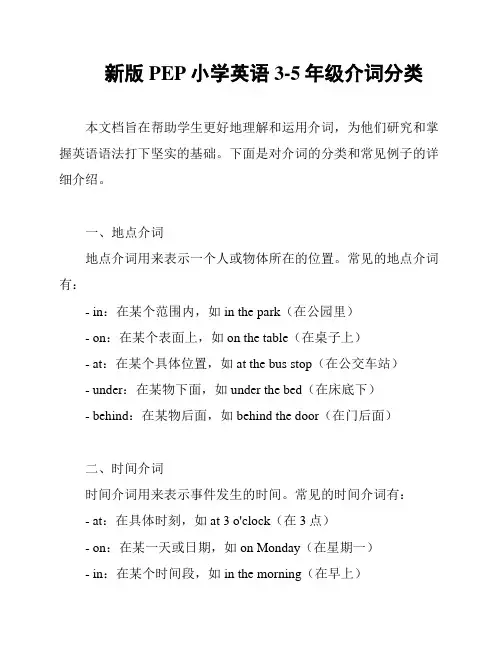
新版PEP小学英语3-5年级介词分类本文档旨在帮助学生更好地理解和运用介词,为他们研究和掌握英语语法打下坚实的基础。
下面是对介词的分类和常见例子的详细介绍。
一、地点介词地点介词用来表示一个人或物体所在的位置。
常见的地点介词有:- in:在某个范围内,如in the park(在公园里)- on:在某个表面上,如on the table(在桌子上)- at:在某个具体位置,如at the bus stop(在公交车站)- under:在某物下面,如under the bed(在床底下)- behind:在某物后面,如behind the door(在门后面)二、时间介词时间介词用来表示事件发生的时间。
常见的时间介词有:- at:在具体时刻,如at 3 o'clock(在3点)- on:在某一天或日期,如on Monday(在星期一)- in:在某个时间段,如in the morning(在早上)- during:在某个时间段内,如during summer vacation(在暑假期间)- after:在某个时间点之后,如after school(放学后)三、方向介词方向介词用来表示运动或定位的方向。
常见的方向介词有:- to:表示朝向某个地点,如go to school(去学校)- into:表示进入某个地点,如go into the room(进入房间)- out of:表示离开某个地点,如get out of the car(下车)四、方式介词方式介词用来表示做事情的方式或手段。
常见的方式介词有:- by:用某个方式或手段,如go to work by bus(乘公交车上班)- with:用某个工具或伴随某人,如write with a pen(用钢笔写字)- without:没有某个东西或人,如go to the party without my sister(没有我妹妹的派对)五、原因介词原因介词用来表示某事发生的原因。
小学英语常用介词及用法
小学英语常用介词及用法常见介词及用法(一)表示时间的介词1.英语里最常见的时间介词有:at, in, on, before, after和from。
2.at , in和XXX这三个词都表示时间。
at主要指具体的钟点:at half past eight在八点半XXX一般指某一段时间:in XXX在一月份on指具体在某一天:on XXX在星期一3.before和XXX表示时间的先后顺序。
XXX表示“在……之前”。
XXX.吃饭前你应该洗手。
XXX表示“在……之后”。
They often play basketball after XXX.他们放学后经常打篮球。
4.from作时间介词含有“从……开始”的意思,常和to连用,组成“from…to…”的结构,透露表现“从……到……”的意义。
We go to school from Monday to Friday.我们从周一到周五上学。
(二)表示方位的介词,也就是表示位置和地点的介词。
1.小学阶段常见的方位介词有:on, in, at, under, over, above, below, about,around, between等。
2.on, over和above这三个词都有“在……上面”的意思,但它们所表示的方位还是有些不同。
on表示两个物体的表面相互接触。
如:There is a book on the desk.桌上有一本书。
The boy is XXX那个孩子睡在地上。
over透露表现“在……的正上方”,两个物体表面没有打仗。
如:There is a light bulb over my head.在我头顶上有一个灯泡。
above透露表现两个物体中一个在另外一个的上方,如:XXX.飞机上云层上飞行。
1There are four lights above our head.在我们头上有四盏灯。
3.under和below都有“在……的下面”的意思,但它们有区别:under表示“在……的正下方”,其反义词是over。
小学英语方位介词讲解课件
小学英语方位介词讲解课件篇一:小学英语介词和连词讲解介词:prep.表时间的介词口诀:年月季节前用in,日期星期要用on,几月几号也用on,上下午晚上又是in,若是某天上下午,要用on来,不用in.this/ that/ next/ last/every前不加介。
今那天下一上一at 时间真具体,正午午夜到黎明。
noon night dawn例子:in on at /1. ___this morning2. _in__20133. _in__summer4. _in__May5. _in__the morning6. _on__Sundays7. _on_ June, 4th8. _on_the morning of July, 26th9. _at_7:30pm 10._at__dawn11. _/__ next week12. _/_that year地点介词:at---在小地点at schoolin---在大地点或静止的地点in Beijingon---在露天或平面的场所on the farmon the Ti’anmen Squareon the playground方位介词:9个in on under behind in front of 在前面between next to near aroundin the front of 在前部in在境内on接壤to 不相邻表方位China is __on__the north of North Korea. Guangzhou is _in__the south of China .America is __to_ the east of China. 方式介词:by in withby---乘坐by bike by train by busby plane=by airin---用+ (原材料)with---用+(工具)戴带着和….在一起in ink in pencil=with a pen =with a pencilthe girl with a pair of glassesHe goes shopping with his mum. The teacher came in with a book. in特殊:in+颜色(穿着)the boy in red连词与并列句:conj.(and/ but/ or/ so/因此所以和、并且但是或者、否则not only ….but also/both…and/不仅。
广州版小学英语方位介词的学习讲课讲稿
微课教学设计
设计者:广州市天河区岑村小学 英语科组
时间:2014年4月1日
微课名称:
广州版小学英语方位介词的学习
学科类型:
小学英语
教学环节类型:
语言知识点巩固和新授
教学活动类型:
讲授类
教学时间:
7分钟
教学对象:
小学三年级学生,对游戏教学比较感兴趣,已经掌握 in、on、under、文具、家具单词,对near、beside、behind、in front of有初步的认知
教学理念:
1. 创设情景,让学生在语境中理解所学语言知识点;2. 引导学生对所学知识点进行归纳。
案例1
微课课例评价意见
设计者
广州市天河区岑村小学 英语科组
单位
岑村小学
微课名称
方位介词的学习
学科
英语
点评
1、导入方式恰到好处:通过创设情景引领学生对旧知in、on、under进行复习,对near、beside、behind、in front of等4个方位介词进行新授学习。 2、重难点的突破设计巧妙:利用透视图帮助学生对每个介词含义进行理解,并在课程中利用互动游戏帮助学生进行知识巩固,最后让学生构建一张方位图帮助其对该7个介词进行汇总理解及记忆。3、教学方法体现"以学生为中心":互动游戏的设置、方位图的自主建构,都强调让学生参与课堂、在意义建构中掌握知识。例:每一个新的方位图,都让学生在玩找机器人的游戏中掌握知识与技能,轻松愉快中突破重难点。 4、PPT课件美观:音画同步符合兴趣与认知、ppt的色彩搭配、字体呈现引人入胜。同时每一个问题提出后,留出3秒的思考时间,让学生思考完再呈现答案。 5、配套的"自主学习任务单"让学生乐学:以闯关的形式设置的五关任务——说区别、填介词(基于情境)、标方位(依视频)、判正误、写收获、生自评,每一个环节都充满教师智慧,体现层层深入的思想。6、总结到位,提升学生对知识的整体把握。 7、微课的制作技术上,为了体现交互性,在学生进行活动的相应视频环节,用了一点小心机(即在ppt制作,留出时间给学生进行任务的操作。
小学英语常用介词用法详解及练习
小学英语常用介词用法详解及练习介词在句子中表示名词或代词等与其他词之间的关系。
不能单独作句子成分,常位于名词或代词(或与之相当的他词类、短语、从句)前面构成介词短语。
介词后面的成分作介词的宾语。
介词,是表示两词之间的关系的词。
我们在小学英语中学习的英语介词有:一、时间介词• 1.on( 1 ) 在------上面 The book is on the desk.( 2 ) 在------(哪一天/星期)What do you do on Wednesday?( 3 ) 在------(月、日)My birthday is on August 2nd.• 2.in(1)在------里面 The pens are in the pencil-box.(2)在------(哪一年/月)His birthday is in October. He wor ked here in 1992.(3)在------(地方) He works in Dongguan.•(4)在------之内 What are you going to do in 20 years?•(5)在------(早上、下午、晚上)I do morning exercises in the morning every day.I usually play basketball in the afternoon.I often do my homework in the evening.• 3.at(1)在------(点钟)I usually go to school at 8:00 am.(2)在中午 at noon二、方位介词• 1. under 在------底下 There is a ball under the bed.• 2. near 在------附近 There is a book shop near ourschool.• 3. in front of在------前面A boy is standing in front of the house.• 4. beside 在------旁边 A football is beside thedoor.• 5. next to 紧挨着 There is a bus station next to No. 13 Middle School.• 6. over 在------正上方 A bridge is over the river.•7. on the left在------左边 The bookstore is on the left.•8. on the right在------右边The hospital is on the right.•9. before在……之前 Mike sits before me.•10. after在------以后 He went home after school.•11. in the middle在------中间The road is in the middle.•12. at(1)在------(小地方) I am at school today.I was at home yesterday.(2)看一看 Look at the blackboard.•13. behind 在------后面There is a broom behind the door.。
- 1、下载文档前请自行甄别文档内容的完整性,平台不提供额外的编辑、内容补充、找答案等附加服务。
- 2、"仅部分预览"的文档,不可在线预览部分如存在完整性等问题,可反馈申请退款(可完整预览的文档不适用该条件!)。
- 3、如文档侵犯您的权益,请联系客服反馈,我们会尽快为您处理(人工客服工作时间:9:00-18:30)。
时间介词与方位介词
一.时间介词(in, on, at):
1.in表示“在一段时间内或一天内的部分时间”,用于某年,季节,月份,一段时间或
泛指的一天中的上午,下午,晚上等前面。
(1)in 2014
(2)in spring/summer/autumn/winter
(3)in January/February/March/April/May/June/July/August/
September/October/November/December
(4)in the morning/afternoon/evening
2.on表示“某一天或某一天内的部分时间”,用于星期,节日,具体的某一天或具体
日子的上午,下午,晚上等前面。
(1)on Monday/Tuesday/Wednesday/Thursday/Friday/Saturday/Sunday
(2)on Children’s Day(儿童节)/Women’s Day(妇女节)
(3)on December 27
(4)on Saturday morning
3.at表示“某指定时间”,用于重点时间前,也可用于一天中的某段特定时间,如黎
明(dawn),中午(noon),黄昏(dusk),午夜(midnight)。
(1)at 8:00 o’clock
(2)at noon/dawn/dusk/midnight
4.用法比较:
二、地点介词(in, at, on):
at (1)表示在小地方(<城镇); (2)表示“在……附近,旁边”例:at school, at the door
如:I saw Jiamin at the swimming pool.
See you at the party.
in (1)表示在大地方(>城镇); (2)表示“在…范围之内”。
例:in china, in the school yard
如:He lives in Paris with his wife.
on (1)表示在物体表面;(2)表示在某个方向
例:on the table 在桌子上on the left/right 在左边/右边
三.方位介词:
1. 含义:用来表示人或物的位置的词语。
2. 常见的方位介词:above, below, under, below, behind, in front of, beside, in, on等。
3. 用法:
难点一:in the tree 和on the tree
on the tree 在树上(从树上长出来的东西,比如水果、叶子)in the tree 在树上(外来的物品,比如小鸟、蚂蚁)
难点二:on & over
on 在... 上面(两者有接触)over 在...上方(两者没接触,比如人跟天花板)
难点三:beside 与next to
(1)beside 在...旁边(不挨着) 看图例↓↓↓
(2)next to 在...旁边(紧挨着) 看图例↓↓↓
练习-基础篇:
一.根据中文提示,用适当的方位介词填空:
1.There is a big tree __________ (在……的前面) my house.
2. Who was _________ (在……的后面) you when you were waiting in a line?
3. What’s _______(在……的下面)the desk?
4. The tallest boy in my class sits ________ (在……的旁边) me.
5. They are standing _______ the classroom. (在……的前面)
二、单项选择
1.---Where is my schoolbag, Mum? I can’t find it.
---Oh, I put it _______ the door just now.
A. above
B. below
C. behind
D. beside
2. Can you see the hole(洞) _____ the wall?
A. on
B. in
C. among
D. between
3. There is a map(地图) ______ the wall.
A. on
B. from
C. in
D. at
4. The hill is______ the lake.
A. front
B. in front
C. in front of
D. in front at
5. ---Where is the library?
---It’s______ the art room?
A. next
B. behind
C. front
D. in front 练习-高级篇
1.选择填空
1.Michael Jordan is a great American basketball player. He was born_________ 1963.
A.on
B. at
C. in
D. for
2.My mother’s birthda y is_________ June 15 th.
A.on
B. at
C. in
D. for
3. ---What time does your mother get home every day?
---_________ five o’clock.
A.At
B. On
C. In
D. For
4. A lot of students in our school were born____ March, 1981.
A. in
B. at
C. on
D. since
5. My grandfather was born____ October 10th, 1935.
A. on
B. in
C. at
D. of
6. Mike does his exercises ____ seven _____ the evening.
A. on; to
B. at; in
C. by; of
D. at; on
7. Mrs. Brown came to China ____ 1996.
A. on
B. of
C. to,
D. in
8. The English teacher told me to get there____ half past ten.
A. in
B. at
C. on
D. of
9.There are some birds ____ the tree.
A. in
B. at
C. on
D. of
10.There are some apples ____ the tree.
A. in
B. at
C. on
D. of
二.填空题。
1. My friend now lives _____ Shanghai
(我的朋友住在上海。
)
2. I'll meet you _____ the shopping mall.
(我在购物中心见你。
)
3. The postoffice is the left of the bank
(邮局在银行的左边)
4. The party will be the school meeting room.
(聚会将会在学校会议室举行)
5.I grew up Guangzhou.
(我在广州长大。
)。
